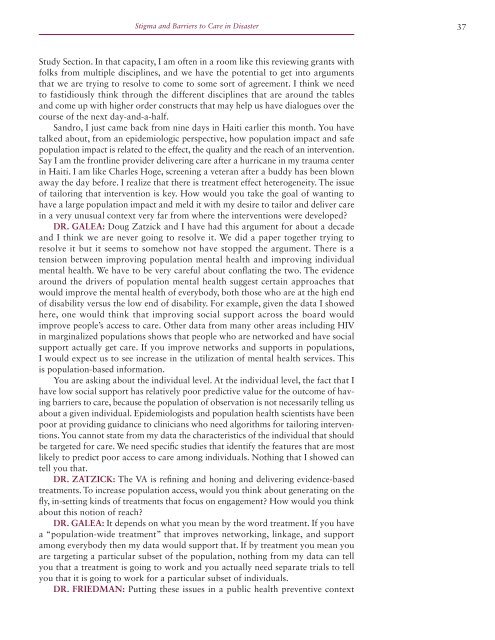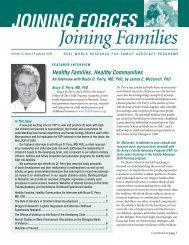stigma and barriers to care - Uniformed Services University of the ...
stigma and barriers to care - Uniformed Services University of the ...
stigma and barriers to care - Uniformed Services University of the ...
You also want an ePaper? Increase the reach of your titles
YUMPU automatically turns print PDFs into web optimized ePapers that Google loves.
Stigma <strong>and</strong> Barriers <strong>to</strong> Care in Disaster 37<br />
Study Section. In that capacity, I am <strong>of</strong>ten in a room like this reviewing grants with<br />
folks from multiple disciplines, <strong>and</strong> we have <strong>the</strong> potential <strong>to</strong> get in<strong>to</strong> arguments<br />
that we are trying <strong>to</strong> resolve <strong>to</strong> come <strong>to</strong> some sort <strong>of</strong> agreement. I think we need<br />
<strong>to</strong> fastidiously think through <strong>the</strong> different disciplines that are around <strong>the</strong> tables<br />
<strong>and</strong> come up with higher order constructs that may help us have dialogues over <strong>the</strong><br />
course <strong>of</strong> <strong>the</strong> next day-<strong>and</strong>-a-half.<br />
S<strong>and</strong>ro, I just came back from nine days in Haiti earlier this month. You have<br />
talked about, from an epidemiologic perspective, how population impact <strong>and</strong> safe<br />
population impact is related <strong>to</strong> <strong>the</strong> effect, <strong>the</strong> quality <strong>and</strong> <strong>the</strong> reach <strong>of</strong> an intervention.<br />
Say I am <strong>the</strong> frontline provider delivering <strong>care</strong> after a hurricane in my trauma center<br />
in Haiti. I am like Charles Hoge, screening a veteran after a buddy has been blown<br />
away <strong>the</strong> day before. I realize that <strong>the</strong>re is treatment effect heterogeneity. The issue<br />
<strong>of</strong> tailoring that intervention is key. How would you take <strong>the</strong> goal <strong>of</strong> wanting <strong>to</strong><br />
have a large population impact <strong>and</strong> meld it with my desire <strong>to</strong> tailor <strong>and</strong> deliver <strong>care</strong><br />
in a very unusual context very far from where <strong>the</strong> interventions were developed<br />
DR. GALEA: Doug Zatzick <strong>and</strong> I have had this argument for about a decade<br />
<strong>and</strong> I think we are never going <strong>to</strong> resolve it. We did a paper <strong>to</strong>ge<strong>the</strong>r trying <strong>to</strong><br />
resolve it but it seems <strong>to</strong> somehow not have s<strong>to</strong>pped <strong>the</strong> argument. There is a<br />
tension between improving population mental health <strong>and</strong> improving individual<br />
mental health. We have <strong>to</strong> be very <strong>care</strong>ful about conflating <strong>the</strong> two. The evidence<br />
around <strong>the</strong> drivers <strong>of</strong> population mental health suggest certain approaches that<br />
would improve <strong>the</strong> mental health <strong>of</strong> everybody, both those who are at <strong>the</strong> high end<br />
<strong>of</strong> disability versus <strong>the</strong> low end <strong>of</strong> disability. For example, given <strong>the</strong> data I showed<br />
here, one would think that improving social support across <strong>the</strong> board would<br />
improve people’s access <strong>to</strong> <strong>care</strong>. O<strong>the</strong>r data from many o<strong>the</strong>r areas including HIV<br />
in marginalized populations shows that people who are networked <strong>and</strong> have social<br />
support actually get <strong>care</strong>. If you improve networks <strong>and</strong> supports in populations,<br />
I would expect us <strong>to</strong> see increase in <strong>the</strong> utilization <strong>of</strong> mental health services. This<br />
is population-based information.<br />
You are asking about <strong>the</strong> individual level. At <strong>the</strong> individual level, <strong>the</strong> fact that I<br />
have low social support has relatively poor predictive value for <strong>the</strong> outcome <strong>of</strong> having<br />
<strong>barriers</strong> <strong>to</strong> <strong>care</strong>, because <strong>the</strong> population <strong>of</strong> observation is not necessarily telling us<br />
about a given individual. Epidemiologists <strong>and</strong> population health scientists have been<br />
poor at providing guidance <strong>to</strong> clinicians who need algorithms for tailoring interventions.<br />
You cannot state from my data <strong>the</strong> characteristics <strong>of</strong> <strong>the</strong> individual that should<br />
be targeted for <strong>care</strong>. We need specific studies that identify <strong>the</strong> features that are most<br />
likely <strong>to</strong> predict poor access <strong>to</strong> <strong>care</strong> among individuals. Nothing that I showed can<br />
tell you that.<br />
DR. ZATZICK: The VA is refining <strong>and</strong> honing <strong>and</strong> delivering evidence-based<br />
treatments. To increase population access, would you think about generating on <strong>the</strong><br />
fly, in-setting kinds <strong>of</strong> treatments that focus on engagement How would you think<br />
about this notion <strong>of</strong> reach<br />
DR. GALEA: It depends on what you mean by <strong>the</strong> word treatment. If you have<br />
a “population-wide treatment” that improves networking, linkage, <strong>and</strong> support<br />
among everybody <strong>the</strong>n my data would support that. If by treatment you mean you<br />
are targeting a particular subset <strong>of</strong> <strong>the</strong> population, nothing from my data can tell<br />
you that a treatment is going <strong>to</strong> work <strong>and</strong> you actually need separate trials <strong>to</strong> tell<br />
you that it is going <strong>to</strong> work for a particular subset <strong>of</strong> individuals.<br />
DR. FRIEDMAN: Putting <strong>the</strong>se issues in a public health preventive context




